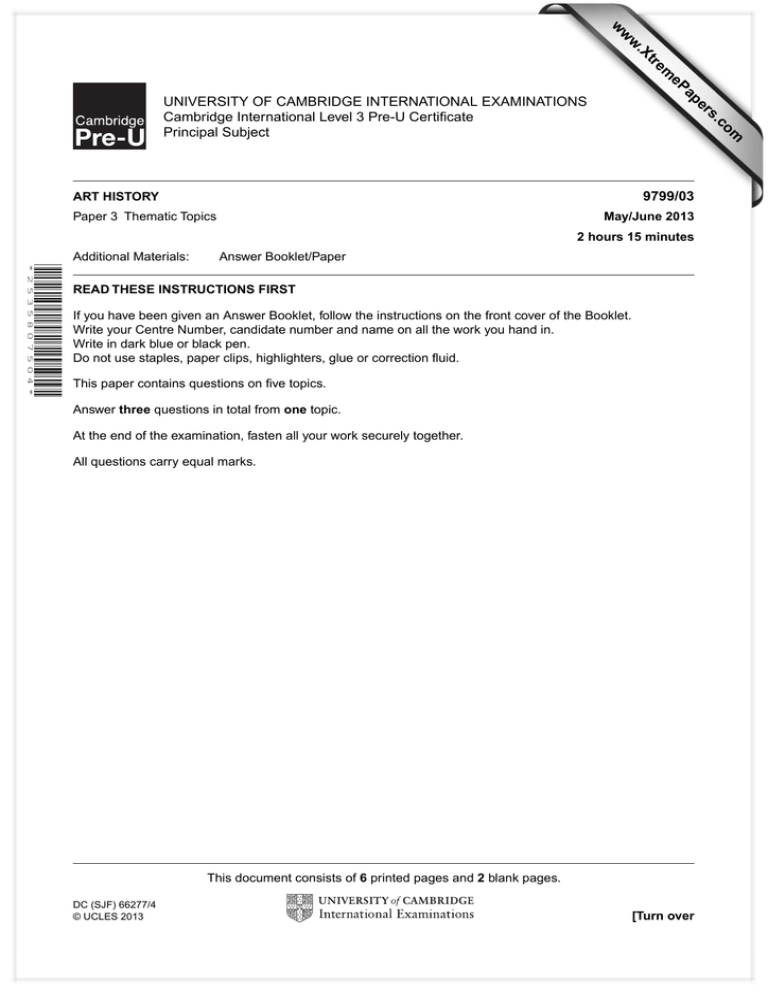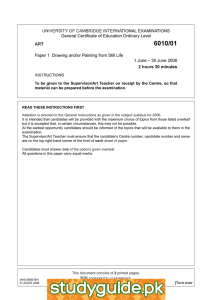
w
w
ap
eP
m
e
tr
.X
w
om
.c
s
er
UNIVERSITY OF CAMBRIDGE INTERNATIONAL EXAMINATIONS
Cambridge International Level 3 Pre-U Certificate
Principal Subject
9799/03
ART HISTORY
Paper 3 Thematic Topics
May/June 2013
2 hours 15 minutes
Additional Materials:
Answer Booklet/Paper
* 2 5 3 5 8 0 7 5 0 4 *
READ THESE INSTRUCTIONS FIRST
If you have been given an Answer Booklet, follow the instructions on the front cover of the Booklet.
Write your Centre Number, candidate number and name on all the work you hand in.
Write in dark blue or black pen.
Do not use staples, paper clips, highlighters, glue or correction fluid.
This paper contains questions on five topics.
Answer three questions in total from one topic.
At the end of the examination, fasten all your work securely together.
All questions carry equal marks.
This document consists of 6 printed pages and 2 blank pages.
DC (SJF) 66277/4
© UCLES 2013
[Turn over
2
Topic 1: Art and Architecture in the City
Unless the question clearly indicates otherwise, candidates are advised to base their answers on
detailed discussion of three or four case studies. It is recommended that candidates do not discuss the
same works in different answers.
1
How can architecture play a role in demonstrating the economic growth of a city? Discuss with
reference to at least two buildings in the city of your choice.
2
Can urban planning have a detrimental effect on a city?
3
How are ideas of cultural heritage visible in your chosen city?
4
If you were writing an introduction to your city’s churches, which ones would you choose and why?
Discuss with reference to at least two examples.
5
How do paintings give us an idea of the social life of the city? Discuss with reference to works by
at least two artists.
6
If you had to order a plaque to commemorate a patron (individual or corporate) of the city of your
choice, who would you select? Give reasons and refer to the major works of interest.
7
The experiences of visiting galleries can differ greatly. Discuss with reference to at least one
gallery in the city of your choice.
8
Monuments found in public places help us to understand important figures in the city. Discuss with
reference to specific examples.
© UCLES 2013
9799/03/M/J/13
3
Topic 2: Landscape
Unless the question clearly indicates otherwise, candidates are advised to base their answers on
detailed discussion of three or four case studies. It is recommended that candidates do not discuss the
same works in different answers.
9
Discuss the ways in which landscape has been depicted in any one non-Western artistic tradition.
10 How is the relationship between man and nature explored in at least three landscape paintings of
the seventeenth century?
11 With reference to at least two examples, discuss some British landscape paintings (of any period)
which give a picture of rest and solace.
12 How did nineteenth-century French landscape artists explore the theme of modern life?
13 ‘Landscape photography is the supreme test of the photographer’ (Ansel Adams). Discuss a
selection of landscape photographs in the light of this comment.
14 ‘My remit is to work with nature as a whole’ (Andy Goldsworthy). With reference to at least two
artists, discuss some examples of art produced directly in the environment.
15 If you had the opportunity to mount an exhibition of landscapes by two artists from different
periods, which artists would you choose and why?
16 ‘I know that to paint the sea really well, you need to look at it every hour of every day in the same
place so that you can understand its way in that particular spot; and that is why I am working on
the same motifs over and over again, four or six times even’ (Claude Monet). Discuss the working
practices of any one landscape artist, and comment on how a knowledge of these practices can
help us to understand their art.
© UCLES 2013
9799/03/M/J/13
[Turn over
4
Topic 3: Portraiture
Unless the question clearly indicates otherwise, candidates are advised to base their answers on
detailed discussion of three or four case studies. It is recommended that candidates do not discuss the
same works in different answers.
17 ‘Others in museums pass them by / but I, I / am drawn like a maggot to meat / by their pupilless
eyes / and their putrefying individuality’ (John Updike, ‘Roman Portrait Busts’). How much
individuality do you find in portraits from the ancient world? Your answer should contain detailed
reference to at least three examples.
18 Through selected examples, compare and contrast the art of the portrait in Italy and the
Netherlands in the fifteenth century.
19 Discuss the work of any one portrait artist of the sixteenth century.
20 Discuss a selection of portraits of families and/or couples.
21 How have artists achieved effects in portraits through the use of exaggeration? Examples may be
taken from one period or different periods.
22 ‘I would wish my portraits to be of the people, not like them. Not having a look of the sitter, being
them’ (Lucian Freud). Discuss this statement, with reference to portraits by any artist from the
twentieth century.
23 How do portraits reflect their era?
24 How can a portrait be mysterious?
© UCLES 2013
9799/03/M/J/13
5
Topic 4: The Nude
Unless the question clearly indicates otherwise, candidates are advised to base their answers on
detailed discussion of three or four case studies. It is recommended that candidates do not discuss the
same works in different answers.
25 Why were nude sculptures made in the classical world?
26 ‘Only in countries touching on the Mediterranean has the nude been at home’ (Kenneth Clark).
Respond to this statement with reference to the art of any Western or non-Western culture.
27 How has Christian teaching on sin been reflected in artistic depiction of nudity?
28 Prostitution is a frequent theme in depictions of the nude. Discuss.
29 The Wikipedia entry says that ‘Nude Photography’ should be distinguished from glamour
photography, erotic photography and pornographic photography. Are such distinctions meaningful,
in your view? Illustrate your answer with references to specific works.
30 How have twentieth-century artists engaged with the tradition of the nude? Base your answer on a
few selected examples.
31 Discuss the genre of the nude self-portrait, with close reference to at least two specific works.
32 Compare and contrast three nudes in different media.
© UCLES 2013
9799/03/M/J/13
[Turn over
6
Topic 5: Still Life
Unless the question clearly indicates otherwise, candidates are advised to base their answers on
detailed discussion of three or four case studies. It is recommended that candidates do not discuss the
same works in different answers.
33 Compare and contrast still lifes produced in different societies.
34 Spanish still lifes often express religious fervour. Discuss with reference to at least one work.
35 According to Norman Bryson, still life is one of the most enduring categories of painting. Why do
you think this is so?
36 Still lifes can project eloquent symbolic messages. Discuss.
37 What can still lifes tell us about attitudes to consumption?
38 Can ready-mades be described as still life?
39 Consider the work of Andy Warhol and/or Damien Hirst in the light of the still life genre.
40 How have photographers interpreted the art of still life?
© UCLES 2013
9799/03/M/J/13
7
BLANK PAGE
© UCLES 2013
9799/03/M/J/13
8
BLANK PAGE
Copyright Acknowledgements:
Topic 2 Question 13
Topic 2 Question 14
Topic 3 Question 17
Topic 3 Question 22
Topic 4 Question 26
© Ansel Adams; The Ansel Adams Gallery; All rights reserved.
© Andy Goldsworthy; He’s got the whole world in his hands; http://www.telegraph.co.uk/culture/art/3663966/Hes-got-the-wholeworld-in-his-hands.html; Telegraph Media Group Ltd; 10 August 2012.
© John Updike; ‘Roman Portrait Busts’; Midpoint, and other poems; Deutsch; 1969.
© The Lucian Freud Archive.
© Kenneth Clark; The Nude: A Study in Ideal Form; Princeton University Press; 1972.
Permission to reproduce items where third-party owned material protected by copyright is included has been sought and cleared where possible. Every
reasonable effort has been made by the publisher (UCLES) to trace copyright holders, but if any items requiring clearance have unwittingly been included, the
publisher will be pleased to make amends at the earliest possible opportunity.
University of Cambridge International Examinations is part of the Cambridge Assessment Group. Cambridge Assessment is the brand name of University of
Cambridge Local Examinations Syndicate (UCLES), which is itself a department of the University of Cambridge.
© UCLES 2013
9799/03/M/J/13






